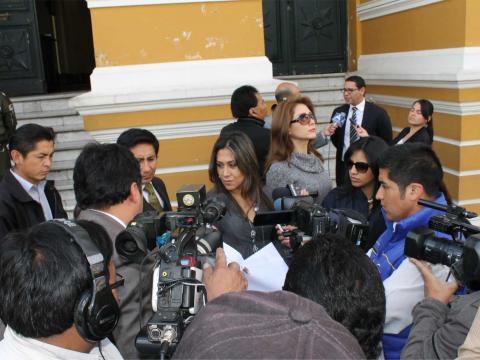
There’s still time for the World Bank to do more for girls and adolescents
WVI’s Abigail Howe Will and Sini Maria Heikkila share why, as the World Bank finalises the public consultation on its new Gender Strategy 2024-2030, it must strengthen its focus on children, particularly girls and adolescents.
22 November 2023
With new President Ajay Banga at the helm and the ongoing Evolution Roadmap Process, it has been a year of change at the World Bank. Not least because the bank has an ambitious goal of accelerating gender equality through its development of a new Gender Strategy.
During this time of significant setbacks to gender equality, many of which were driven by the COVID-19 pandemic, the World Bank’s efforts to engage with greater ambition in this area is vital and worth commending.
Yet, only six years away from 2030, the reality of what the bank faces is a world that is failing women and girls. Only two of the Sustainable Development Goal (SDG) 5 indicators relating to gender equality are considered “close to target,” plus no SDG5 indicator at the “target met or almost met” level underscores the urgent need for concrete actions to accelerate progress towards gender equality.
As a key partner, donor, and agenda setter in global finance and development policy, the role of the World Bank in driving a change agenda to turn the tide for gender equality is crucial.
The draft Gender Strategy for 2024-2030: Accelerate Gender Equality for a Sustainable, Resilient and Inclusive Future is currently being shaped by a broad engagement with World Bank partners, including many civil society organisations. The strategy spotlights elevating human capital, ending gender-based violence, expanding and enabling economic opportunities for women and engaging women as leaders—the latter being a new area of focus for the World Bank.
It is positive to see the bank’s strong priorities regarding tackling gender-based violence and championing women’s participation, decision-making and leadership. These focus areas span the spectrum of commitments that are needed to achieve gender equality and women’s and girls’ empowerment.
More Focus needed on Girls and Adolescents
Yet, it is concerning to see the lack of focus on children, particularly girls and adolescents who face unique vulnerabilities. Furthermore, we are concerned about the lack of strong recognition of the wider lifecycle approach—a recognition how empowerment occurs in different ways throughout an individual’s life stages with challenges and opportunities. This approach recognises that freedoms, rights, skills, and opportunities that a woman may have in adulthood are built on a foundation of age-appropriate freedoms, rights, skills and opportunities they experienced during each stage of childhood.
In World Vision’s feedback to the World Bank on its gender strategy, we urged the World Bank to recognise how the impact of gender inequality and social exclusion reach from birth across all life stages.
The journey to realise gender equality, empowerment and full rights for everyone—regardless of nationality, race, religion, gender, disability—starts in childhood and adolescence. Thus, any intervention or framework (policies, laws or programmes) addressing gender inequality needs to imbed the lifecycle approach recognising and addressing the ways in which the impacts of gender inequality and social exclusion reach from birth across all life stages for diverse groups of women and girls.
In particular, adolescence is a period where gender disparities become more pronounced. Many challenges faced by adolescent girls including the disproportionate shouldering of unpaid care work; increased risks of sexual violence and early pregnancy; pressures or expectations to marry; and barriers to accessing education or quality food are exacerbated for girls who face multiple discrimination.
World Vision has a long history of working to support adolescents and addressing gender equality through different life cycle stages. One of our successful projects is the Improving Gender Attitudes, Transition, and Education outcomes Programme in Zimbabwe which targeted the specific education and vocational needs and interests of marginalised adolescent girls in Zimbabwe to support their successful transition to their next life stage. Overall, this programme succeeded in supporting adolescent girls (especially out-of-school girls) as well as young mothers to transition to employment.
Elevating Girls’ Voice and Agency
It is great to see a strong focus on women’s leadership and participation in the bank’s new Gender Strategy. Yet, we note with concern the lack of references to girls’ voices and agency.
A global survey of 29,000 girls and young women aged 15-24 from 29 countries, found that respondents face significant barriers whilst taking part in political activities and feel poorly represented by the decisionmakers elected to serve them. Only half (50 %) reported believing that people in their community think it is acceptable for girls and young women to engage in political activities.
Listening to girls and ensuring their voices is not only the right thing to do, but it can also have wider positive impacts for the World Bank’s work. Thus, it is important to actively include the voices and experiences of girls – particularly those who are marginalised – in the development and shaping of policies that affect their lives. This could be done, for instance, through including children’s and adolescents’ groups and networks in consultations and meaningful participation in decision making.
Abigail Howe Will, Gender Equality and Social Inclusion Technical Director (Abigail_will@wvi.org) and Sini Maria Heikkila, Senior Advisor for External Engagement (sini_heikkila@wvi.org) can be reached for additional information.

